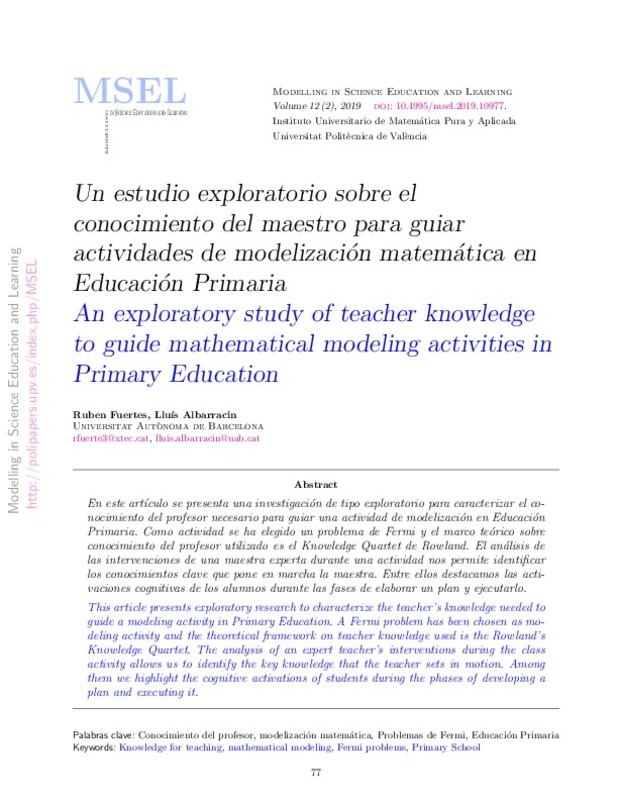Albarracíın, L. (2017). Los problemas de fermi como actividades para introducir la modelización: qué sabemosy qué más deberíamos saber. Modelling in Science Education and Learning,10(2), 117-136. https://doi.org/10.4995/msel.2017.7707
Albarracín, L., & Gorgorió, N. (2014). Devising a plan to solve fermi problems involving large numbers.Educational Studies in Mathematics,86(1), 79-96. https://doi.org/10.1007/s10649-013-9528-9
Albarracín, L., & Gorgorió, N. (2018). Students estimating large quantities: From simple strategies to thepopulation density model.EURASIA Journal of Mathematics, Science and Technology Education,14,10. https://doi.org/10.29333/ejmste/92285
[+]
Albarracíın, L. (2017). Los problemas de fermi como actividades para introducir la modelización: qué sabemosy qué más deberíamos saber. Modelling in Science Education and Learning,10(2), 117-136. https://doi.org/10.4995/msel.2017.7707
Albarracín, L., & Gorgorió, N. (2014). Devising a plan to solve fermi problems involving large numbers.Educational Studies in Mathematics,86(1), 79-96. https://doi.org/10.1007/s10649-013-9528-9
Albarracín, L., & Gorgorió, N. (2018). Students estimating large quantities: From simple strategies to thepopulation density model.EURASIA Journal of Mathematics, Science and Technology Education,14,10. https://doi.org/10.29333/ejmste/92285
Albarracín, L., Lorente, C., Lopera, A., Pérez, H., & Gorgorió, N. (2015). Problemas de estimación de grandes cantidades en las aulas de educación primaria. Epsilon,32(89), 19-33.
Ärlebäck, J. B. (2009). On the use of realistic fermi problems for introducing mathematical modelling in school.The Mathematics Enthusiast,6(3), 331-364.
ÄrlebÄck, J. B. (2011). Exploring the solving process of groups solving realistic fermi problem from theperspective of the anthropological theory of didactics. In Proceedings of the seventh congress of the european society for research in mathematics education(pp. 1010-1019).
Ball, D., Thames, M. H., & Phelps, G. (2008). Content knowledge for teaching: What makes it special? Journal of teacher education,59(5), 389-407. https://doi.org/10.1177/0022487108324554
Blum, W. (2002). Icmi study 14: Applications and modelling in mathematics education-discussion document.Educational studies in mathematics,51(1-2), 149-171. https://doi.org/10.1023/A:1022435827400
Blum, W., & Leiss, D. (2007). How do students and teachers deal with modelling problems. In Mathematical modelling (ictma 12): Education, engineering and economics(pp. 222-231). https://doi.org/10.1533/9780857099419.5.221
Boukafri, K., Civil, M., & Planas, N. (2018). A teacher's use of revoicing in mathematical discussions. In Language and communication in mathematics education(pp. 157-169). Springer. https://doi.org/10.1007/978-3-319-75055-2_12
Carrillo, J., Climent, N., Contreras, L., & Muñoz-Catalán, M. (2013). Mathematics teacher specialized knowl-edge.Proceedings of the 8th CERME. Turkey.
Czocher, J. A. (2016). Introducing modeling transition diagrams as a tool to connect mathematical modeling to mathematical thinking. Mathematical Thinking and Learning,18(2), 77-106. https://doi.org/10.1080/10986065.2016.1148530
Diago, P., Ortega, M., Puig, L., & Ferrando, I. (2016). Diseño e implementación de tareas de modelización con ipad©: un enfoque dual. Modelling in Science Education and Learning,9(1), 35-56. https://doi.org/10.4995/msel.2016.4427
Doerr, H. M., & English, L. D. (2003). A modeling perspective on students' mathematical reasoning about data. Journal for research in mathematics education, 110-136. https://doi.org/10.2307/30034902
Efthimiou, C. J., & Llewellyn, R. A. (2007). Cinema, fermi problems and general education.Physics education,42(3), 253. https://doi.org/10.1088/0031-9120/42/3/003
Fennema, E., & Franke, M. L. (1992).Teachers' knowledge and its impact.Macmillan Publishing Co, Inc.
Ferrando, I., Albarracín, L., Gallart, C., García-Raffi, L. M., & Gorgorió, N. (2017). Análisis de los modelos matemáticos producidos durante la resolución de problemas de fermi.Boletim de Educaçao Matemática,31(57), 220-242. https://doi.org/10.1590/1980-4415v31n57a11
Ferrer, M., Fortuny, J. M., & Morera, L. (2014). Efectos de la actuaci ́on docente en la generaci ́on de oportunidades de aprendizaje matemático.Enseñanza de las ciencias: revista de investigación y experiencias didácticas,32(3), 385-405. https://doi.org/10.5565/rev/ensciencias.1231
Gallart, C., Ferrando, I., García-Raffi, L. M., Albarracín, L., & Gorgorió, N. (2017). Design and implementationof a tool for analysing student products when they solve fermi problems. In Mathematical modelling andapplications(pp. 265-275). Springer. https://doi.org/10.1007/978-3-319-62968-1_23
Lesh, R., & Harel, G. (2003). Problem solving, modeling, and local conceptual development.Mathematicalthinking and learning,5(2-3), 157-189. https://doi.org/10.1080/10986065.2003.9679998
Peter-Koop, A. (2009). Teaching and understanding mathematical modelling through fermi-problems. In Tasks in primary mathematics teacher education(pp. 131-146). Springer. https://doi.org/10.1007/978-0-387-09669-8_10
Petrou, M., & Goulding, M. (2011). Conceptualising teachers' mathematical knowledge in teaching. In Mathematical knowledge in teaching(pp. 9-25). Springer. https://doi.org/10.1007/978-90-481-9766-8_2
Pólya, G. (1945).How to solve it. Princeton University Press, Princeton. https://doi.org/10.1515/9781400828678
Robinson, A. (2008). Dont just stand there - teach fermi problems!Physics Education,43(1), 83. https://doi.org/10.1088/0031-9120/43/01/009
Rowland, T. (2013). The knowledge quartet: the genesis and application of a framework for analysing math-ematics teaching and deepening teachers' mathematics knowledge.Sisyphus-Journal of Education,1(3),15-43.
Rowland, T., Huckstep, P., & Thwaites, A. (2005). Elementary teachers' mathematics subject knowledge: Theknowledge quartet and the case of naomi. Journal of Mathematics Teacher Education,8(3), 255-281. https://doi.org/10.1007/s10857-005-0853-5
Rowland, T., & Turner, F. (2007). Developing and using the 'knowledge quartet': A framework for the observation of mathematics teaching.The Mathematics Educator,10(1), 107-124.
Schoenfeld, A. H. (1985).Mathematical problem solving. Academic Press, Inc.
Shulman, L. S. (1986). Those who understand: Knowledge growth in teaching.Educational researcher,15(2),4-14. https://doi.org/10.3102/0013189X015002004
Sriraman, B., & Knott, L. (2009). The mathematics of estimation: Possibilities for interdisciplinary pedagogy and social consciousness.Interchange,40(2), 205-223. https://doi.org/10.1007/s10780-009-9090-7
Stohlmann, M. S., & Albarrac ́ın, L. (2016). What is known about elementary grades mathematical modelling.Education Research International,2016. https://doi.org/10.1155/2016/5240683
Turner, F., & Rowland, T. (2011). The knowledge quartet as an organising framework for developing and deep-ening teachers' mathematics knowledge. In Mathematical knowledge in teaching(pp. 195-212). Springer. https://doi.org/10.1007/978-90-481-9766-8_12
Vorhölter, K., Kaiser, G., & Borromeo Ferri, R. (2014). Modelling in mathematics classroom instruction: Aninnovative approach for transforming mathematics education. In Transforming mathematics instruction(pp. 21-36). Springer. https://doi.org/10.1007/978-3-319-04993-9_3
Weinstein, L., & Adam, J. A. (2009).Guesstimation: Solving the world's problems on the back of a cocktailnapkin. Princeton University Press. https://doi.org/10.1515/9781400824441
Winter, H. (1994). Modelle als konstrukte zwischen lebensweltlichen situationen und arithmetischen begriffen.Grundschule,26(3), 10-13.
[-]









